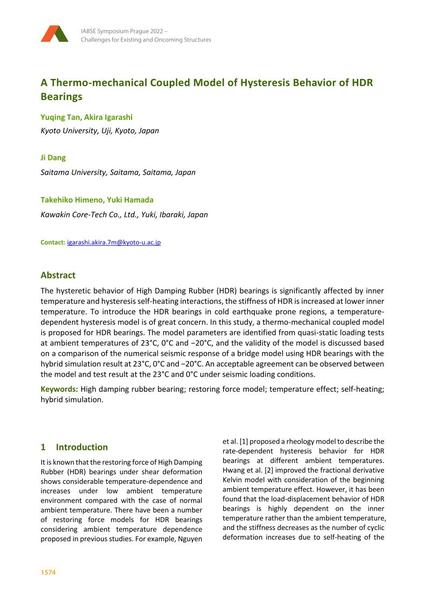A Thermo-mechanical Coupled Model of Hysteresis Behavior of HDR Bearings

|
|
|||||||||||
Bibliografische Angaben
| Autor(en): |
Yuqing Tan
(Kyoto University, Uji, Kyoto, Japan)
Akira Igarashi (Kyoto University, Uji, Kyoto, Japan) Ji Dang (Saitama University, Saitama, Saitama, Japan) Takehiko Himeno (Kawakin Core-Tech Co., Ltd., Yuki, Ibaraki, Japan) Yuki Hamada (Kawakin Core-Tech Co., Ltd., Yuki, Ibaraki, Japan) |
||||
|---|---|---|---|---|---|
| Medium: | Tagungsbeitrag | ||||
| Sprache(n): | Englisch | ||||
| Tagung: | IABSE Symposium: Challenges for Existing and Oncoming Structures, Prague, Czech Republic, 25-27 May 2022 | ||||
| Veröffentlicht in: | IABSE Symposium Prague 2022 | ||||
|
|||||
| Seite(n): | 1574-1581 | ||||
| Anzahl der Seiten (im PDF): | 8 | ||||
| DOI: | 10.2749/prague.2022.1574 | ||||
| Abstrakt: |
The hysteretic behavior of High Damping Rubber (HDR) bearings is significantly affected by inner temperature and hysteresis self-heating interactions, the stiffness of HDR is increased at lower inner temperature. To introduce the HDR bearings in cold earthquake prone regions, a temperature- dependent hysteresis model is of great concern. In this study, a thermo-mechanical coupled model is proposed for HDR bearings. The model parameters are identified from quasi-static loading tests at ambient temperatures of 23°C, 0°C and −20°C, and the validity of the model is discussed based on a comparison of the numerical seismic response of a bridge model using HDR bearings with the hybrid simulation result at 23°C, 0°C and −20°C. An acceptable agreement can be observed between the model and test result at the 23°C and 0°C under seismic loading conditions. |
||||
| Stichwörter: |
Temperatureinfluss
|
||||
| Copyright: | © 2022 International Association for Bridge and Structural Engineering (IABSE) | ||||
| Lizenz: | Die Urheberrechte (Copyright) für dieses Werk sind rechtlich geschützt. Es darf nicht ohne die Zustimmung des Autors/der Autorin oder Rechteinhabers/-in weiter benutzt werden. |
||||
